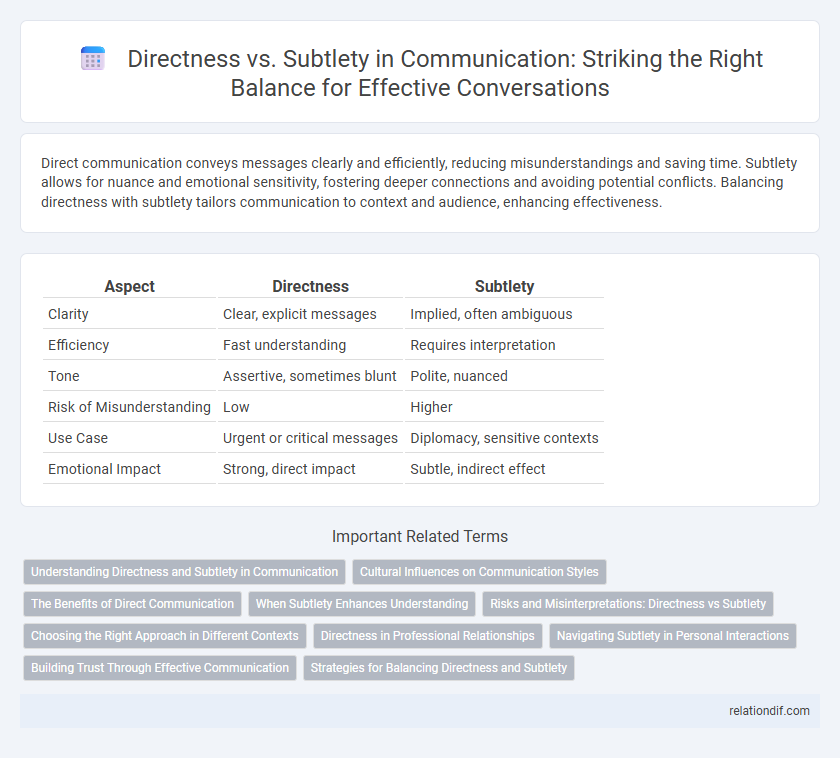Direct communication conveys messages clearly and efficiently, reducing misunderstandings and saving time. Subtlety allows for nuance and emotional sensitivity, fostering deeper connections and avoiding potential conflicts. Balancing directness with subtlety tailors communication to context and audience, enhancing effectiveness.
Table of Comparison
| Aspect | Directness | Subtlety |
|---|---|---|
| Clarity | Clear, explicit messages | Implied, often ambiguous |
| Efficiency | Fast understanding | Requires interpretation |
| Tone | Assertive, sometimes blunt | Polite, nuanced |
| Risk of Misunderstanding | Low | Higher |
| Use Case | Urgent or critical messages | Diplomacy, sensitive contexts |
| Emotional Impact | Strong, direct impact | Subtle, indirect effect |
Understanding Directness and Subtlety in Communication
Directness in communication involves clear, unambiguous messages that prioritize efficiency and straightforwardness, enhancing immediate comprehension and decision-making. Subtlety, characterized by nuanced language and indirect expressions, facilitates preserving relationships and conveying sensitive information without causing offense. Balancing these approaches based on context, audience, and goals optimizes effective communication and mutual understanding.
Cultural Influences on Communication Styles
Cultural influences significantly shape communication styles, with some cultures valuing directness and others emphasizing subtlety to convey messages. High-context cultures, such as Japan and Arab countries, rely on indirect, nuanced communication to maintain harmony and avoid confrontation. In contrast, low-context cultures like the United States and Germany prioritize explicit, straightforward language to ensure clarity and efficiency in interactions.
The Benefits of Direct Communication
Direct communication enhances clarity by minimizing misunderstandings and ensuring messages are conveyed efficiently. It fosters trust and transparency, which strengthen relationships in personal and professional settings. Clear and straightforward expressions accelerate decision-making and problem-solving processes, improving overall productivity.
When Subtlety Enhances Understanding
Subtlety in communication enhances understanding by allowing messages to be interpreted through context, tone, and nuance, which often leads to deeper emotional connection and reduced conflict. Direct communication focuses on clarity and explicitness but can sometimes create defensiveness or oversimplify complex ideas. Employing subtlety strategically benefits sensitive discussions, cross-cultural exchanges, and situations requiring diplomacy or tact.
Risks and Misinterpretations: Directness vs Subtlety
Direct communication minimizes risks of misinterpretation by clearly conveying intentions, while subtlety can introduce ambiguity, leading to misunderstandings or overlooked messages. Excessive subtlety may result in recipients missing critical information or misreading the sender's true meaning, increasing the chance of communication breakdowns. Balancing directness with appropriate nuance is essential to reduce risks associated with unclear or unintended messages.
Choosing the Right Approach in Different Contexts
Directness in communication enhances clarity and reduces misunderstandings, making it ideal for urgent or high-stakes situations. Subtlety fosters relational harmony and cultural sensitivity, proving effective in diplomatic or emotionally charged contexts. Assessing the audience, purpose, and cultural norms ensures the chosen approach maximizes message impact and reception.
Directness in Professional Relationships
Directness in professional relationships enhances clarity and reduces misunderstandings, fostering efficient teamwork and decision-making. Clear, concise communication builds trust and ensures alignment on goals and expectations. Emphasizing directness accelerates problem-solving and promotes accountability within organizations.
Navigating Subtlety in Personal Interactions
Navigating subtlety in personal interactions requires keen attention to tone, body language, and context to interpret underlying messages accurately. Subtle communication often conveys emotions and intentions that direct language may overlook, fostering deeper understanding and connection. Balancing directness with nuance enhances interpersonal effectiveness by respecting individual communication styles and cultural differences.
Building Trust Through Effective Communication
Direct communication fosters clarity and reduces misunderstandings, essential for building trust in relationships by ensuring intentions and expectations are transparent. Subtlety, when used appropriately, can convey empathy and respect, enhancing emotional connection without overwhelming or offending the receiver. Balancing directness with subtlety cultivates a communication style that is both honest and considerate, strengthening trust and collaboration in personal and professional interactions.
Strategies for Balancing Directness and Subtlety
Effective communication strategies balance directness and subtlety by tailoring messages to the audience's preferences and cultural context, enhancing clarity while preserving politeness. Employing active listening and feedback loops ensures that the intended message is understood without causing offense or ambiguity. Utilizing assertive language combined with tactful phrasing helps convey important points decisively and respectfully.
directness vs subtlety Infographic

 relationdif.com
relationdif.com